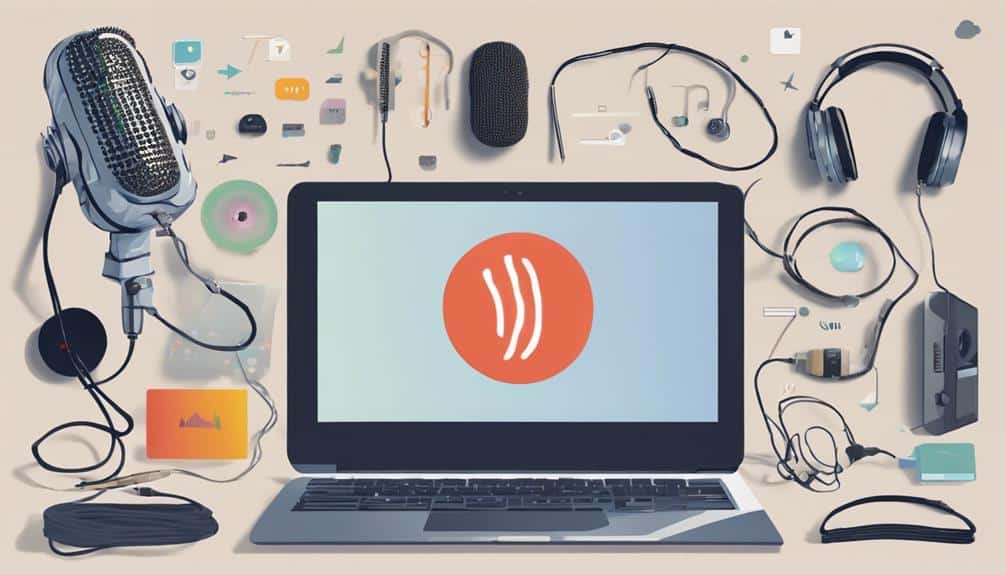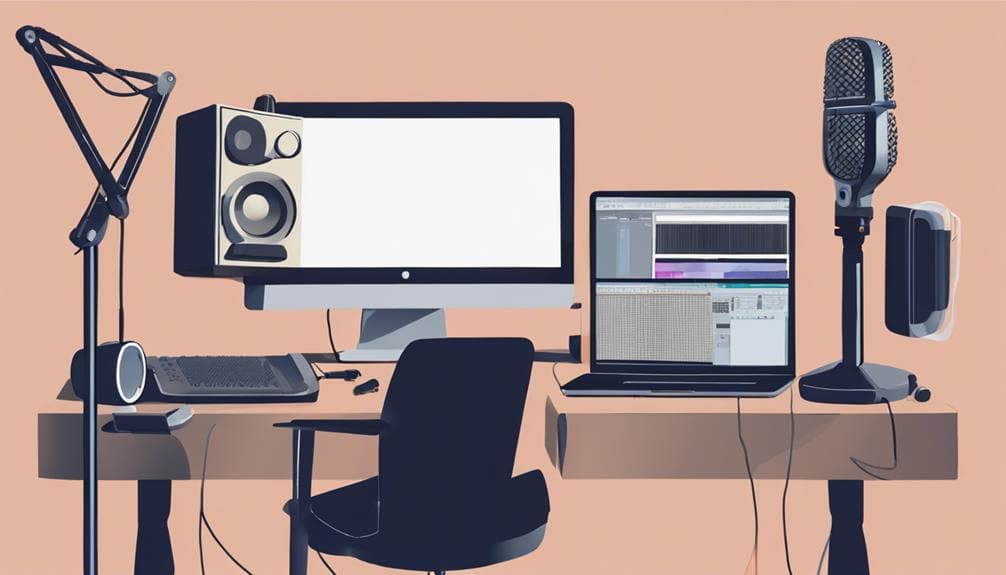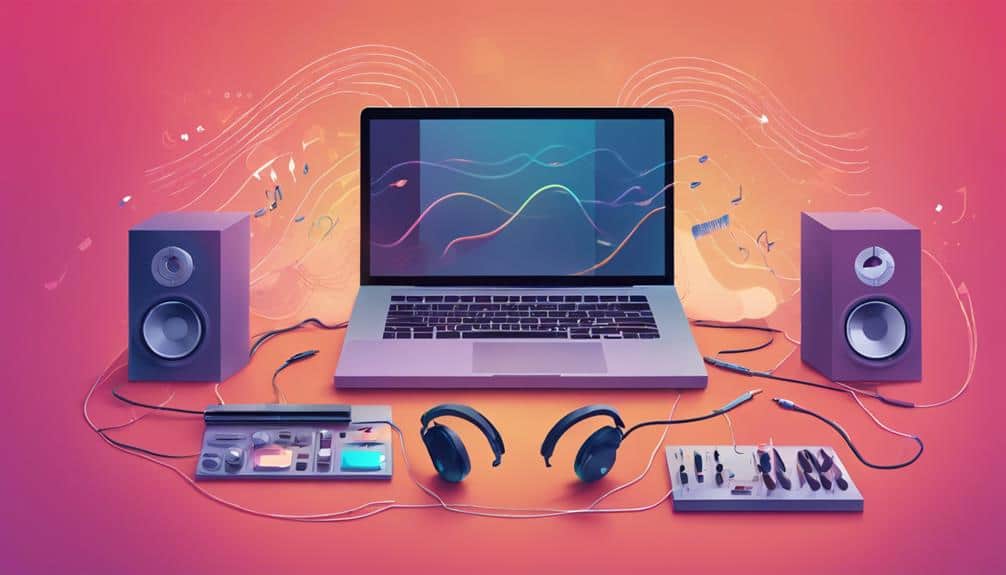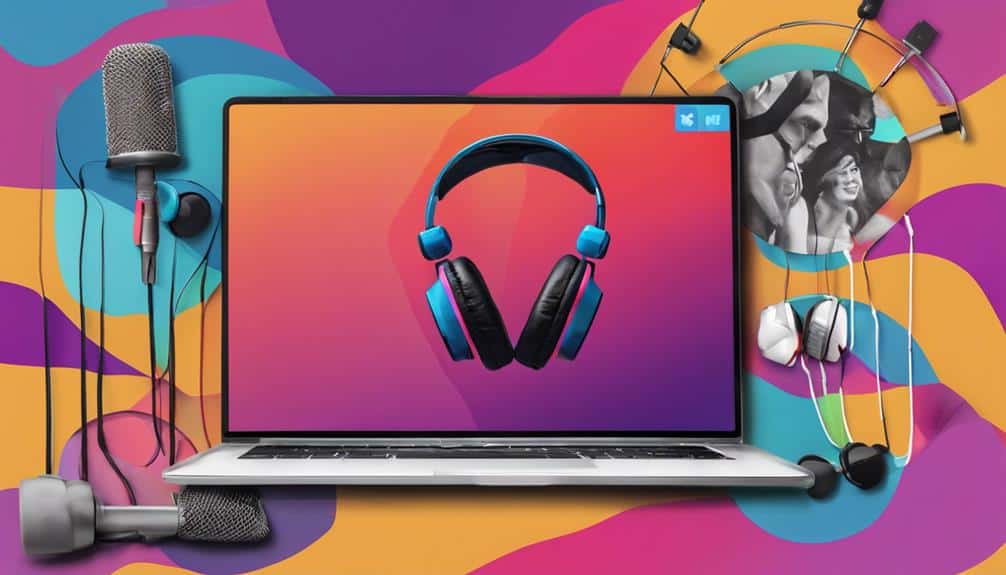You can start a podcast for free by defining your niche and planning engaging content, then choosing a catchy title and selecting free recording tools like Zoom and VEED.IO. Plan a consistent schedule and use free editing software like Audacity or GarageBand to produce high-quality episodes. You'll also need to promote your podcast on social media, engage with online communities, and submit to popular directories. By following these steps, you'll be well on your way to creating a podcast that resonates with your target audience. And, with a little more effort, you can take your podcast to the next level and build a loyal listener base.
Key Takeaways
• Define a niche to attract a dedicated audience and plan engaging topics with unique angles to stand out in a crowded podcast space.
• Choose a catchy title with relevant keywords, balancing catchiness with search-friendliness, and add a tagline for context.
• Utilize free recording tools like Zoom and VEED.IO, and invest in a quality microphone for professional-sounding podcasts.
• Establish a consistent release schedule, plan topics and guests with a content calendar, and enhance listener engagement with regular episodes.
• Edit and produce episodes using free software like Audacity or GarageBand, cutting out background noise, adding music/sound effects, and refining content.
Define Your Podcast Niche
To create a podcast that resonates with listeners, start by defining your niche, which is a specific topic or theme that aligns with your passions and expertise. This is essential because it helps you attract a dedicated audience interested in your unique content. By narrowing down your niche, you'll be able to cater to a specific audience, increasing the chances of building a loyal listener base.
When defining your podcast niche, consider your target audience's preferences and needs. What're they interested in learning or exploring? What problems do they need help solving? By understanding your audience's demands, you'll be able to create content that resonates with them.
Research popular podcast niches to understand audience demand and competition in the market. This will help you identify gaps in the market and create content that stands out. A well-defined niche helps differentiate your podcast from others, making it more attractive to listeners.
Choose a Catchy Podcast Title

Now that you've defined your podcast niche, it's crucial to give your show a name that will grab listeners' attention and make them want to tune in! Your podcast title is the first thing potential listeners will see, so it's vital to get it right.
A catchy podcast title should clearly communicate your show's content and resonate with your target audience. To make your title more discoverable, incorporate relevant keywords strategically. This will improve your podcast's searchability and attract listeners who are interested in your niche.
However, don't sacrifice catchiness for search-friendliness. You need to strike a balance between the two to attract and retain listeners. Consider adding a tagline to your podcast title to provide additional context and make it more memorable.
This will give potential listeners a better idea of what your show is about and make them more likely to tune in. Ultimately, your podcast title should align with your content and appeal to your target audience. Take your time, and don't be afraid to experiment until you find the perfect title that represents your show.
Select Free Recording Tools

You'll need the right tools to bring your podcast to life, and fortunately, there are some fantastic free recording tools available that can help you get started. With the right tools, you'll be able to create high-quality audio recordings that will make your podcast stand out on platforms like Spotify.
For recording, you can use Zoom's free version, which allows you to record podcast interviews with guests for up to 40 minutes per session. This is a great option if you plan on having guests on your show.
Additionally, you can use VEED.IO, a free online video editing tool, to enhance your podcast videos before sharing them on YouTube or other platforms.
When it comes to editing your audio, you'll need a reliable editing tool. While there are many paid options available, there are also some great free alternatives. You can use online resources to find free audio editing software that suits your needs.
Music is another important aspect of your podcast. You'll need intro, outro, and background music to make your podcast engaging. Pixabay offers a collection of royalty-free music that you can use for your podcast. This will save you money and make sure that you're not infringing on any copyrights.
Plan Engaging Content Ideas

Now that you've got your recording tools in place, it's time to focus on planning engaging content ideas for your podcast.
You'll want to define your niche topic and identify your target audience to create content that resonates with them.
Define Your Niche Topic
By homing in on a specific subject or theme that genuinely fascinates you, you'll increase your chances of creating engaging content that resonates with your target audience. Defining your niche topic is an essential step in starting a podcast, as it sets the tone for your content strategy and helps you stand out in a crowded podcasting space.
Here are some tips to help you define your niche topic:
- Identify your passion: Choose a subject that you're knowledgeable about and enthusiastic about sharing with others.
- Research popular topics: Look at trending podcasts and identify gaps where your unique perspective can shine.
- Differentiate your content: Develop a unique angle or spin on your niche topic to differentiate your podcast from competitors.
- Plan engaging episode topics: Develop a content strategy that includes formats, guest appearances, and topics that will keep your audience engaged.
Identify Target Audience
As you've defined your niche topic, it's time to focus on the people who'll be tuning in to your podcast, and understanding your target audience is key to creating content that resonates with them.
To get started, define your target audience by age, gender, interests, and listening habits to tailor your content effectively. Conduct market research to understand your audience's needs, preferences, and content consumption habits. This will help you create listener personas based on demographics, psychographics, and behavior patterns for targeted content creation.
Engage with your audience through surveys, social media interactions, and feedback to refine your content ideas. Use analytics tools to track listener demographics, engagement metrics, and feedback for continuous improvement.
Develop Content Calendar
Creating a content calendar is crucial for planning compelling podcast topics and guest appearances in advance, guaranteeing a consistent publishing schedule that keeps your audience engaged. This will help you stay organized, focused, and ensure your podcast remains interesting and fresh.
To develop a content calendar, consider the following ideas:
- Trending topics: Use tools like Google Trends to identify popular topics and incorporate them into your podcast content.
- Online communities: Engage with online communities related to your podcast niche to gather ideas and insights from your target audience.
- Competitor analysis: Analyze your competitors' content to inspire new ideas and differentiate your podcast in the market.
- Keyword research: Conduct keyword research to identify relevant topics and phrases that resonate with your audience.
Set Up a Consistent Schedule

To cultivate anticipation and loyalty with your audience, you'll want to establish a consistent schedule for releasing new episodes of your podcast. This will keep your listeners engaged and eagerly waiting for your next episode.
Plan ahead to guarantee regular episodes are released on time, and use a content calendar to organize topics and guest appearances. This will help you stay organized and ensure that you're consistently producing high-quality content.
Establishing a routine for recording and editing will also help you maintain consistency. Decide on a specific day and time to record and edit your episodes, and stick to it. This will help you stay on track and avoid delays.
Consistency in podcast release dates can also enhance listener engagement and retention. When your audience knows when to expect new episodes, they're more likely to tune in regularly.
Record High-Quality Audio

With your schedule in place, you're ready to focus on capturing high-quality audio that will engage and retain your audience, starting with investing in a good microphone to guarantee clear and crisp recordings.
A quality microphone is essential for producing professional-sounding podcasts. It's worth investing in a decent microphone, as it will greatly enhance your audio recording and editing process.
Here are some essential tips to help you record high-quality audio:
- Choose a quiet recording environment to minimize background noise and distractions.
- Use a pop filter to reduce unwanted sounds like plosives and breath noises.
- Adjust microphone settings for best sound levels and clarity in your recordings.
- Experiment with different recording techniques and distances from the microphone to find the best audio quality.
Edit and Produce Your Episodes

Now that you've recorded your podcast episodes, it's time to edit and produce them to make them shine!
You'll learn how to use free editing software, like Audacity or GarageBand, to refine your recordings and make them sound professional.
From cutting out background noise to adding music and sound effects, you'll discover the essential steps to create engaging episodes that captivate your audience.
Audio Editing Software
You'll need free audio editing software to edit and produce your podcast episodes, and luckily, there are some great options available. Two popular choices are Audacity and GarageBand, both of which offer a range of features to help you create professional-sounding episodes.
Here are some key benefits of using these free audio editing software options:
- Multi-track editing: Audacity allows you to edit multiple tracks simultaneously, making it easy to work with interviews or panel discussions.
- Noise reduction and audio effects: Audacity also offers noise reduction and audio effects, giving you more control over the sound quality of your podcast.
- User-friendly interface: GarageBand is known for its user-friendly interface, making it easy to get started with podcast production, even if you have no prior experience.
- Compatibility and exporting options: Both Audacity and GarageBand support various audio formats and exporting options, making it easy to distribute your podcast to your desired platforms.
Recording Session Tips
To guarantee your podcast episodes sound professional and engaging, consider incorporating a few key elements during your recording sessions.
First, invest in a good quality microphone and consider using a pop filter or microphone stand to improve the clarity of your recordings.
Next, choose a quiet recording space with minimal background noise, and use noise reduction tools to eliminate any unwanted sounds.
During your recording session, speak clearly and at a comfortable pace, and don't be afraid to pause or retake a section if needed.
When it comes to editing, use free editing software like Audacity or GarageBand to refine your podcast recordings. These programs offer a range of features, including noise reduction tools and effects, to help you enhance the quality of your podcast.
Experiment with different editing techniques to find the best style that suits your podcast format.
Episode Post-Production
With your recording sessions complete, it's time to transform your raw audio into a polished podcast episode through post-production editing. This is where the magic happens, and you get to refine your episode into an engaging and professional-sounding podcast.
Here are the key steps to focus on during episode post-production:
- Enhance your podcast's audio: Use editing software like Audacity to remove background noise and improve overall sound quality.
- Create a seamless flow: Add music, sound effects, and connections to create a seamless and engaging podcast episode.
- Ensure consistent volume levels: Make sure the volume is consistent throughout the episode for a pleasant listening experience.
- Refine your content: Edit out any mistakes, pauses, or irrelevant content to keep the episode concise and engaging.
Remember to also consider adding show notes, timestamps, and calls to action to guide listeners and enhance engagement.
Create a Professional Podcast Cover

Crafting a professional podcast cover is an important step in establishing your show's visual identity, and fortunately, you can create one easily using free online tools like Canva or Castos Dynamo.
This visual representation of your podcast will be the first thing potential listeners see, so it's vital to make it count. A well-designed podcast cover can attract new listeners and make your show stand out in crowded podcast directories.
To create an eye-catching cover, consider your podcast's theme and content. Incorporate relevant images or graphics that reflect your show's tone and style. Don't forget to include your podcast title and branding elements, such as logos or color schemes, to maintain consistency. Use high-resolution images and clear fonts to make sure your cover looks professional and is easy to read.
With Canva or Castos Dynamo, you can choose from a variety of templates and customization options to create a unique design that represents your podcast. You can also experiment with different colors, fonts, and layouts to find the perfect combination that showcases your brand.
Publish Your Podcast Online

You've got your podcast recorded and edited, now it's time to share it with the world! When publishing your podcast online, you'll need to think about the best hosting options, file formats, and distribution channels to guarantee your podcast reaches your target audience.
In this section, we'll explore the various options available to you, from Spotify to YouTube, to help you make informed decisions about how to get your podcast out there.
Hosting Options Abound
When it comes to publishing your podcast online, you'll find a multitude of free hosting options at your disposal, each offering a unique set of features to help you get your show out to the masses.
- Anchor: Record and edit your podcast within the platform, and monetize through sponsorships.
- Podbean: Enjoy unlimited storage, easy episode uploads, and engage with your audience through comments.
- Buzzsprout: Leverage detailed analytics on listener demographics, popular episodes, and listening trends to optimize your content strategy.
- Other options: Explore other free podcast hosting platforms, each with their own set of features and benefits.
These hosting options offer more than just storage for your files. They provide distribution to major podcast directories, basic analytics to track your performance, and tools to help you grow your audience.
File Format Matters
As you prepare to publish your podcast online, selecting the right file format is crucial to guarantee a seamless listening experience across different platforms and devices.
You'll need to choose between MP3 and WAV, the two most popular file formats for podcasts. MP3 is the most widely used format due to its small file size and high compatibility with various podcast hosting platforms. This format is ideal for podcasters who prioritize file size over audio quality.
On the other hand, WAV files offer superior audio quality but come with larger file sizes, which may affect upload and download speeds. When deciding between MP3 and WAV, consider the balance between file size and audio quality that suits your podcast's needs.
Distribution Channels
With your podcast files ready, it's time to share them with the world through popular distribution channels like Spotify, Apple Podcasts, Google Podcasts, and Stitcher. These platforms will help you reach a wider audience and gain more listeners.
Uploading your podcast to multiple distribution channels increases its visibility and accessibility.
Here are some key takeaways to keep in mind:
- Distribute your podcast via multiple platforms: Reach a broader audience by uploading your podcast to multiple platforms.
- Use RSS feeds: Automatically distribute new episodes to various platforms using RSS feeds.
- Choose a reliable podcast hosting platform: Select a podcast hosting provider that allows easy distribution to multiple platforms.
- Regularly update your podcast: Keep your audience engaged by regularly updating your podcast on distribution channels.
Submit to Popular Directories

You can greatly enhance your podcast's visibility by submitting it to popular directories like Apple Podcasts, Spotify, Google Podcasts, and Stitcher. These directories have a massive audience base, allowing your podcast to reach a larger audience. By submitting your podcast to these directories, you're increasing your chances of being discovered by new listeners.
Each directory has its own submission process, requiring details like your podcast title, description, cover art, and RSS feed. Make sure you have all this information ready to go, as it'll make the submission process smoother. Submitting to multiple directories ensures broader distribution and accessibility for listeners.
Regularly updating your podcast on these directories helps maintain a consistent presence and attract new listeners. It's vital to keep your podcast's information up-to-date, so listeners can find and engage with your content easily.
Promote Your Podcast on Social Media

By expanding your podcast's online presence to social media platforms, you can tap into a vast audience and drive engagement around your content. This is where you can connect with your target audience, build a community, and promote your podcast.
Here are some ways to promote your podcast on social media:
- Choose the right platforms: Utilize platforms like Instagram and Twitter to promote your podcast where your target audience is active.
- Create engagement: Create a branded hashtag to encourage community engagement and visibility for your podcast.
- Share behind-the-scenes content: Engage with listeners and share behind-the-scenes content to build a loyal audience on social media.
- Use targeted ads: Use targeted ads on social platforms to reach a broader audience interested in your podcast content.
Engage With Online Communities

Engaging with online communities can be a game-changer for your podcast, as it opens doors to valuable connections, feedback, and insights that can elevate your content and grow your audience. By joining online forums and groups related to your niche, you can tap into a wealth of knowledge and expertise that can inform and improve your podcast content.
| Benefits | Online Communities | Results |
|---|---|---|
| Networking opportunities | Connect with like-minded individuals | Grow your professional network |
| Insights and ideas | Join relevant forums and groups | Improve your podcast content |
| Target audience understanding | Participate in online discussions | Better understand your target audience |
| Increased visibility | Share your podcast with online communities | Boost your podcast's visibility |
| Supportive network | Seek feedback and share knowledge | Build a supportive network |
Can I Use a Free Podcast Platform to Promote My LinkedIn Profile?
Yes, you can use a free podcast platform to promote your LinkedIn profile. By including a call-to-action in your podcast episodes, you can direct listeners to your LinkedIn profile to learn more about your expertise and skills. Take advantage of this opportunity to increase your visibility and remove open to work LinkedIn status.
Monitor and Refine Your Content

Monitoring your podcast's performance is essential to refining your content, as it allows you to pinpoint what resonates with your audience and make data-driven decisions to improve your show. By keeping a close eye on your podcast's analytics, you'll be able to identify areas that need improvement and make adjustments to better engage your listeners.
Here are some key metrics to monitor and refine your content:
- Listener feedback: Pay attention to comments, reviews, and ratings to understand what your audience loves and hates about your podcast.
- Engagement metrics: Track download numbers, retention rates, and listener interactions to gauge the effectiveness of your content.
- Audience demographics: Analyze your podcast's demographics to understand your target audience and create content that resonates with them.
- Content freshness: Experiment with different episode formats, topics, and guest appearances to keep your content fresh and engaging.
Frequently Asked Questions
How Do You Start a Podcast With No Money?
You're excited to start a podcast, but you're broke! Don't worry, you can still make it happen.
To start a podcast with no money, you'll need to get creative. Utilize free podcast hosting platforms, like Anchor, and take advantage of built-in recording and editing tools.
You can even find free music for your intros and outros. With some DIY soundproofing and social media promotion, you'll be broadcasting in no time!
How Much Does It Cost to Start a Podcast?
You're about to start on a thrilling adventure, like an explorer charting new territories. Now, you're wondering, 'How much does it cost to start a podcast?'
Well, the answer is, it can vary widely. While some podcasters invest in fancy equipment, you can start with minimal costs. With free platforms like Spotify for Podcasters and YouTube, you can begin recording with minimal upfront costs.
Utilize free tools like Audacity, and you'll be podcasting in no time, without breaking the bank!
How Do I Start a Podcast With No Experience?
You're new to podcasting and wondering how to start from scratch? Don't worry, you're not alone! You can still create a great podcast with no experience.
Begin by researching podcasting platforms and free recording software like Audacity or GarageBand. Join online communities and watch YouTube tutorials to learn the ropes.
Start simple and gradually expand as you gain experience. You'll be podcasting like a pro in no time!
Do Podcasters Make Money?
You're wondering, do podcasters really make money? The answer is, yes! Successful podcasters rake in cash through sponsorships, ads, donations, and merchandise sales. Top podcasters earn big from partnerships and branded content.
With a growing industry and engaged audiences, the opportunities for monetization are endless. You can leverage your influence for profitable collaborations, just like the pros.
Conclusion
You've made it! You're now a bonafide podcaster, and it didn't cost you a dime. Who needs a fancy studio or a fat wallet to share your voice with the world? Not you, that's for sure.
With these free tools and a dash of creativity, you've managed to turn your passion into a podcast. So, pat yourself on the back, and get ready to entertain, educate, or inspire the world – one free podcast at a time!



